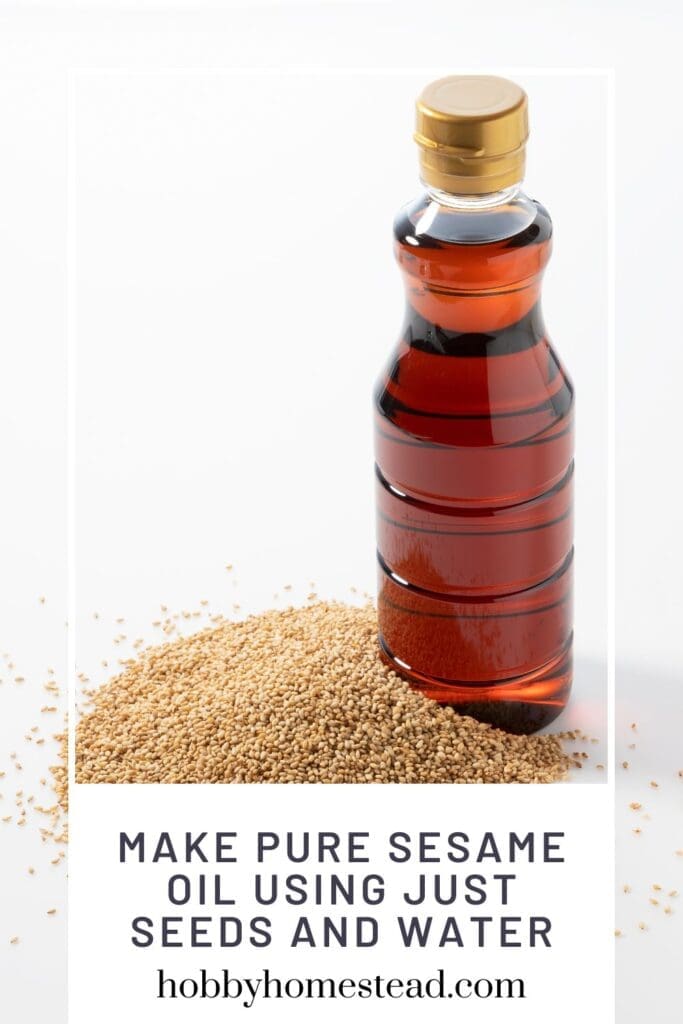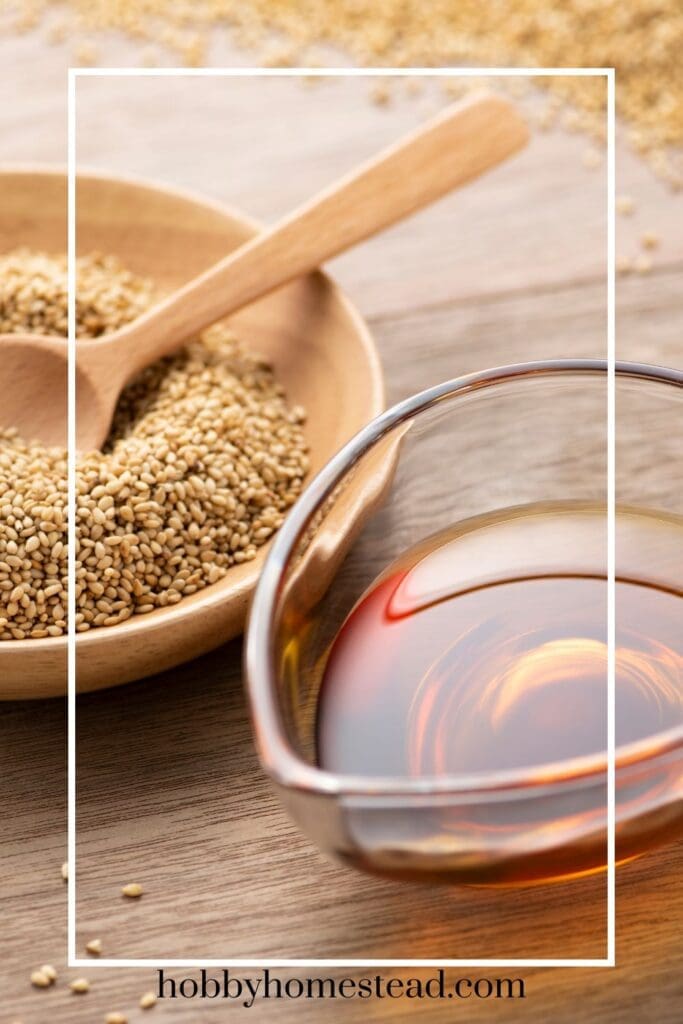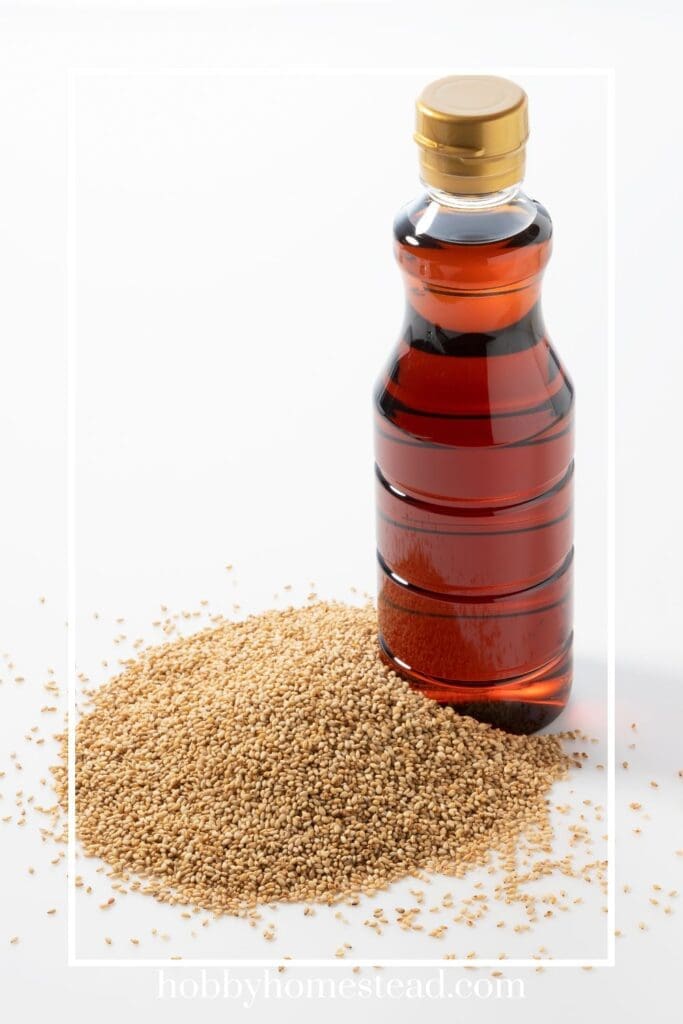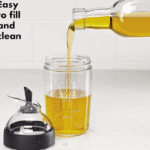Last updated on August 3rd, 2025 at 11:23 am
This traditional method for making pure toasted sesame oil uses only sesame seeds and water. No added oils, no preservatives, just rich, flavorful oil straight from the source.
If you are looking to take your kitchen self-sufficiency to the next level, this one is a keeper. It’s a satisfying and simple process that honors old-world skills while delivering incredible results.
Whether you want to skip store-bought oils or just love learning how things are made, this one’s for you.

Why Make Your Own Sesame Oil?
Most store-bought sesame oils, even the “toasted” varieties, are often diluted with vegetable or soybean oil. When you make it yourself, you’re in full control of the ingredients. Homemade sesame oil has.
- A deeper, nuttier flavor
- No added oils or fillers
- A satisfying DIY process
- Shelf-stable, pantry-ready goodness
It’s a perfect fit for a homestead kitchen, especially for those who want to make the most of natural, whole ingredients.
Make Pure Sesame Oil Using Just Seeds and Water
As an Amazon Associate I earn from qualifying purchases.
Equipment
Ingredients
- 2 Cups Raw Sesame Seeds white or black
- 2 Cups Water for soaking
- 1 ¾ Cups Water for cooking
Instructions
Step-by-Step: How to Make Pure Sesame Oil
- Soak the Seeds Overnight. Place your sesame seeds in a bowl and cover with water. Let them soak overnight (8–12 hours). This softens the seeds and helps with both toasting and oil release.2 Cups Raw Sesame Seeds, 2 Cups Water
- Drain the seeds well using a fine mesh strainer. Add them to a dry skillet over medium heat, stirring frequently. Toast the seeds until golden brown and fragrant. This enhances the flavor of the oil. Be careful not to burn them.
- Grind the Seeds. Once cooled slightly, transfer the toasted seeds to a food processor (or use a mortar and pestle for a more rustic approach). Grind into a coarse, crumbly paste. You’re not looking for sesame butter. Just break up the seeds well enough to release the oils.
- Cook with Water to Release the Oil. Transfer the paste to a nonstick skillet or saucepan. Then, add water in a 1:0.85 ratio. For example:1 ¾ Cups Water
- If you used 1 cup of sesame seed paste, add 0.85 cups (just under 7 oz) of water.
- This ratio allows just enough water to help the oil rise to the surface without oversaturating the mixture. Stir constantly over medium heat. As the water begins to simmer and the mixture heats through, you’ll notice the oil separating and floating to the top.
- Gently skim off the surface oil with a ladle. You can even do some oil sweeping to get a bit more oil from the seeds by pressing gently on the seeds with the back of a ladle or spoon. It helps more oil rise to the surface.
- Once you’ve collected the surface oil, pour it through a cheesecloth or nut milk bag into a clean glass jar. This filters out any lingering solids and gives you clear, aromatic oil.
- Store in an airtight container at room temperature or in the refrigerator.
- Properly strained sesame oil can last 2–3 months (or longer if kept cold and away from light).
Notes
Estimated Oil Yield from 2 Cups of Sesame Seeds:
• 2 cups of sesame seeds (roughly 300–320 grams)• Sesame seeds are about 50–55% oil by weight
• But home extraction methods are less efficient than mechanical presses. Expect to recover 25–35% of that oil content So realistically, you might get:
• About 1/3 to 1/2 cup of pure sesame oil
• Or roughly 80–120 ml
Factors that affect yield:
• How finely the seeds are ground• How hot and evenly you toast them (toasting loosens oil but burning reduces yield)
• How well you “sweep” the oil from the surface
• How patiently you stir and cook during extraction
What Is Oil Sweeping?
“Oil sweeping” is the process of carefully using a ladle to collect the oil that rises to the top of your sesame paste and water mixture. Gently skim off the surface oil without disturbing the solids below.This can take a little time and patience, but it’s rewarding. This is your pure, golden sesame oil!
Nutrition
Tips for Best Results
- Stick to the 1:0 to .85 ratio of sesame paste to water for best results. Too much water will reduce oil yield and make skimming more difficult. Use fresh, high-quality sesame seeds for the richest oil.
- Don’t skip soaking. It helps break down the seed walls.
- Toast gently. Low to medium heat brings out flavor without burning.
- Use a wide pan. It helps maximize oil collection surface.
- Be patient with the oil sweeping. It takes time for oil to rise.

Storage and Shelf Life
- Store in a dark glass jar or wrap your jar in cloth to protect it from light.
- Keep in a cool pantry or refrigerator.
- Oil will stay fresh for 2–3 months, but check for changes in smell or clarity before each use.
Common Mistakes to Avoid
- Burning the seeds. This gives the oil a bitter flavor.
- Skipping the soaking step. This makes oil extraction harder.
- Over-grinding. You want a coarse paste, not tahini.
- Using too much water. Just enough to help oil release is best.

What Can You Use Homemade Sesame Oil For?
- Stir-fries and noodle dishes
- Homemade salad dressings
- Dipping sauces
- Drizzling over rice or roasted vegetables
- Infusing into garlic or chili oil blends
This oil adds an earthy, toasty depth that store-bought oils just can’t match.
DIY Pure Sesame Oil
Making your own pure sesame oil using just seeds and water is a beautiful throwback to simpler, more intentional kitchen practices. It’s a hands-on process that yields a small but flavorful batch of natural oil. No additives, no shortcuts.
Whether you’re trying this out of curiosity, self-reliance, or flavor exploration, it’s a skill worth learning. And once you taste your first batch, you may never go back to store-bought.







A great way to make your own pure sesame seed oil.